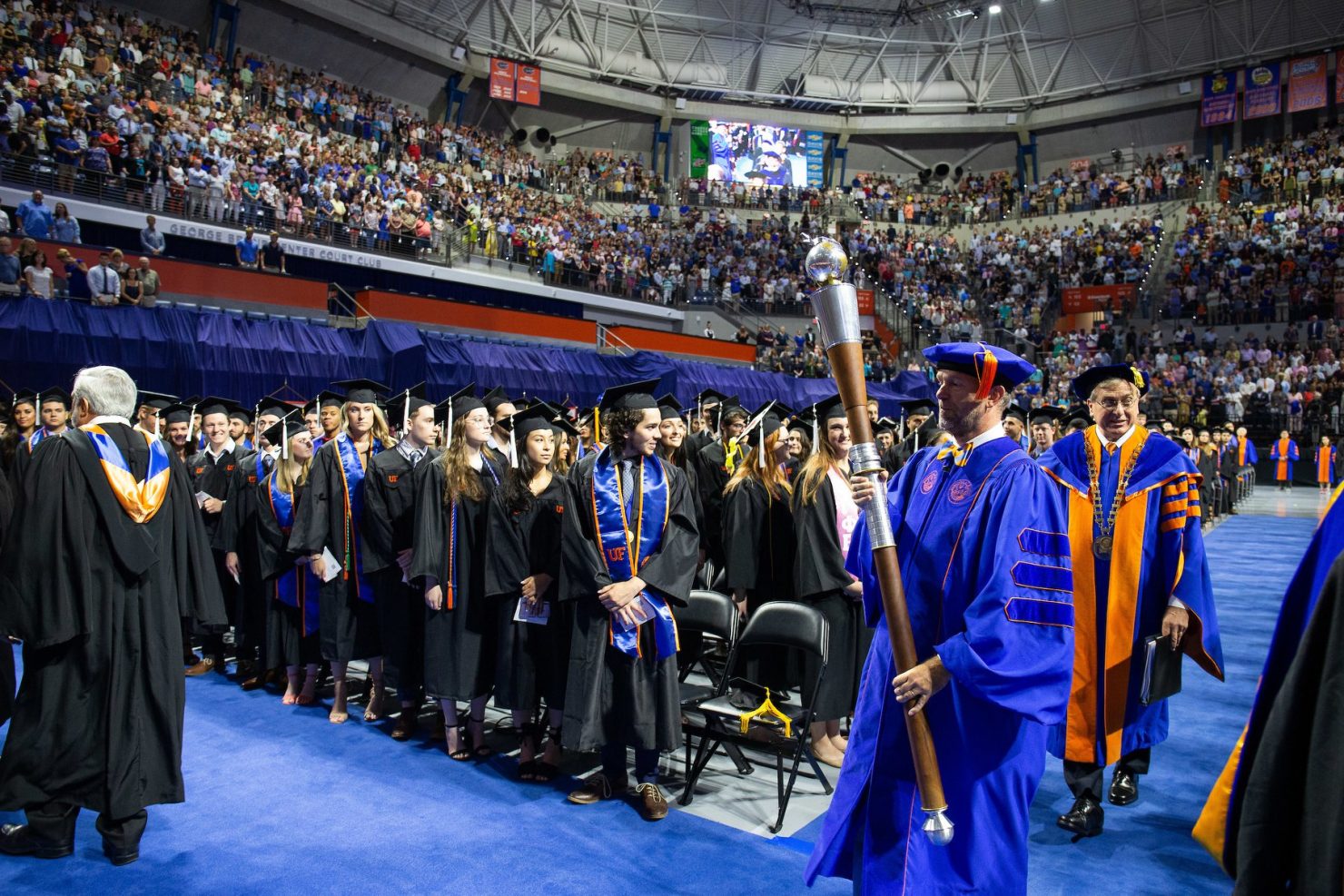Nothing says comeback like the return to in-person commencement ceremonies this spring, and Dr. Hans van Oostrom was happily super busy as Chief Marshal, leading the 26 processionals that marked the graduation festivities. In 2020, in-person commencement ceremonies had to be cancelled due to the COVID-19 pandemic, but this year those graduates were also invited back to join in the festivities.
Graduation in 2021 was a 9-day marathon that started at 7:00 a.m. and ended at 9:00 p.m. each day. “It was an extremely busy time,” Dr. van Oostrom said, “but it was very gratifying when students let us know how happy they were to be there in person this year.”
Dr. van Oostrom, chair of the Department of Engineering Education in the Herbert Wertheim College of Engineering, has been serving as Chief Marshal at UF commencement ceremonies since 2018. He first became a marshal for the Department of Biomedical Engineering in 2002, and he has enjoyed it every year since. For him, it is the culmination of all the hard work he has put into designing programs for students and improving them each semester.
Dr. van Oostrom started his own career as an electrical engineer and faculty member in the UF Department of Anesthesiology, where he became a tenured professor. When Biomedical Engineering was initially started as a cross-disciplinary graduate program between the College of Medicine and the College of Engineering in 1998, Dr. van Oostrom immediately became involved with the group to help build the graduate program. As BME developed into a department, he became the Associate Chair. He continued to develop his passion for engineering education through building the undergraduate programs for BME starting in 2012.
Establishing the Department of Engineering Education
When Dean Cammy Abernathy set the vision to improve the way engineers are taught, Dr. van Oostrom was the person she turned to. First, as the director of the Institute for Excellence in Engineering Education (IE3), he brought together professors from the college’s different departments to teach a number of online classes. The instructors also began using a flipped-classroom approach, where the lectures were taught online for everyone and smaller in-person classes were held so that more individual attention could be given to students as they honed in on course problems.
The IE3 coalesced into the Department of Engineering Education (EED) in June 2019. Over the last two years, EED has grown from 10 faculty members to 24, and is currently one of the most diverse departments in the College. “I’m really pleased with the EED,” Dr. van Oostrom said. “I think it has been a great opportunity for us to build programs that strengthen our college. Hiring excellent, excited people who do a great job at teaching really improves our classes. As a result, we expect to see evidence that more students are retained in engineering and that they graduate sooner.”
“The teaching mission at the University is equally as important as the research mission. The state has invested in instructional faculty, and we offer our faculty positions that are highly valued at the University and at the engineering college. To create an environment where everyone is valued is ongoing work. We have been involved in creating peer evaluations, student evaluations and self-evaluations for instructional professors. We offer them a career plan and a promotional path, strongly supported by our Dean, which helps retain superior faculty,” Dr. van Oostrom commented.
What the Department of Engineering Education does
EED classes include basic courses for all engineers. They teach sophomore and junior students a variety of service courses. For example, “Circuits for Non-Majors” is offered to all engineering students other than electrical engineering majors, with roughly 700-800 students each year. In addition, the EED teaches a large course for the business school in “Problem-solving using computer software,” which serves almost 1,200 business students annually.
This fall, EED will be teaching a freshman design course, “Engineering Design and Society” in the new Herbert Wertheim Laboratory for Engineering Excellence. The course teaches beginning students engineering basics that they can use in future classes and shows them how important the foundation courses such as physics and calculus are to engineers.
EED also performs research on how to educate engineers, a core direction where EED will continue to grow. Most of the instructional professors spend their time teaching, and their research allows them to keep up with their field while expanding what they have learned and applying it to their own courses. EED is now creating a Ph.D. in Engineering Education program to facilitate more research.
Commenting on his experiences since becoming the EED chair, Dr. van Oostrom said, “I now put my teaching passion into mentoring the EED faculty. It’s really gratifying since engineering education is a large and growing field and we receive inquiries all the time. I hope that our program will serve as a national example of what can be accomplished.”
Long term strategic goals and deliverables notwithstanding, Dr. van Oostrom is now just happy to soak in the positive vibes from being with students at the in-person Commencement. “We are looking forward to the coming year, where we can see our students in person once again and where we can introduce first-year students to the new facilities for our freshman design class at the brand new Herbert Wertheim Laboratory for Engineering Excellence,” Dr. van Oostrom said. “And, of course, I am looking forward to leading the processional in the next graduation ceremonies!”
